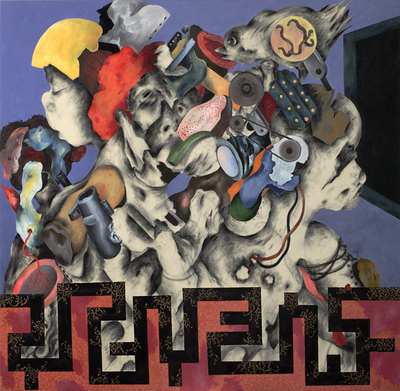AHMED ALSOUDANI: REDACTED
The Portland Museum of Art and the Phoenix Art Museum have collaborated on painter Ahmed Alsoudani’s first museum exhibition, featuring 20 of the artist’s powerfully grotesque figurative abstractions painted in the past three years.
Alsoudani was born in Baghdad in 1975 and fled Iraq in 1995 after defacing a mural of Saddam Hussein. He then lived in Syria for several years before emigrating to the U.S. where he earned a BFA at Maine College of Art in 2005 and an MFA at Yale School of Art in 2008. His meteoric career, based both on his biography and his paintings of war and destruction, took off from there.

Ahmed Alsoudani, Untitled, 2011, charcoal and acrylic on canvas, 63 x 64″. Collection of Darwin and Geri Reedy. © Ahmed Alsoudani. Photo Courtesy of Haunch of Venison, New York.
Alsoudani’s paintings were exhibited at Saatchi Gallery in London in 2009 and 2011, at Haunch of Venison in New York in 2011 and 2012, and he was selected to show at the Iraq Pavilion in the 2011 Venice Biennale. Earlier this year Marlborough Gallery in New York hung Alsoudani’s work with paintings by Francis Bacon, Philip Guston and Paula Rego, heady company for a 38-year old artist just five years out of school.
Explosive as an IED, the paintings feature mangled body parts and grossly distorted figures in dense compositions of inanimate objects such as lamps, light bulbs, cameras, gas masks, plumbing fixtures, tubes, pipes, wires, gears and uprooted trees. The subtext of Alsoudani’s work is observation and surveillance, watching and being watched. Human eyeballs are prominently featured in at least 15 of the 20 paintings.
Personally and socially, Alsoudani uses his art to try to come to terms with violence and war. Materially, as Portland Museum of Art director Mark Bessire points out, “He does battle with drawing and painting.” His paintings combine charcoal and acrylic on the same canvas such that there is always a surface tension between black and white and color. Alsoudani’s sooty charcoals channel the dark art of Max Beckmann and Otto Dix, while his color sense and surreal compositions come straight from his Maine College of Art mentor, Sean Foley.
Ultimately, Ahmed Alsoudani is not a witness to a war he has never seen, but an imaginative conjurer of the chaos and madness, pain and suffering, of all violence and war.
